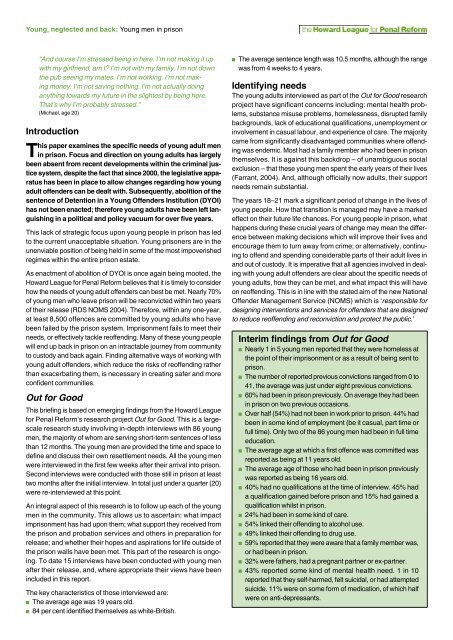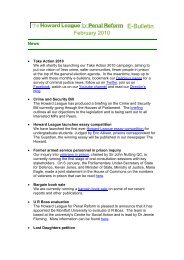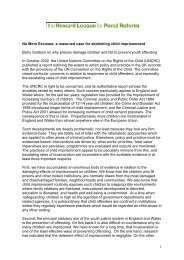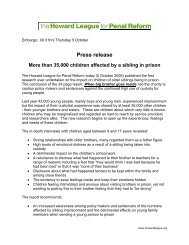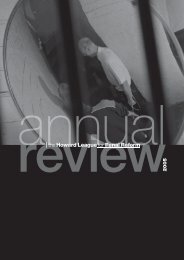Young, neglected and back: young men in prison - The Howard ...
Young, neglected and back: young men in prison - The Howard ...
Young, neglected and back: young men in prison - The Howard ...
- No tags were found...
You also want an ePaper? Increase the reach of your titles
YUMPU automatically turns print PDFs into web optimized ePapers that Google loves.
<strong>Young</strong>, <strong>neglected</strong> <strong>and</strong> <strong>back</strong>: <strong>Young</strong> <strong>men</strong> <strong>in</strong> <strong>prison</strong><br />
“And course I’m stressed be<strong>in</strong>g <strong>in</strong> here. I’m not mak<strong>in</strong>g it up<br />
with my girlfriend, am I I’m not with my family. I’m not down<br />
the pub see<strong>in</strong>g my mates. I’m not work<strong>in</strong>g. I’m not mak<strong>in</strong>g<br />
money. I’m not sav<strong>in</strong>g noth<strong>in</strong>g. I’m not actually do<strong>in</strong>g<br />
anyth<strong>in</strong>g towards my future <strong>in</strong> the slightest by be<strong>in</strong>g here.<br />
That’s why I’m probably stressed.”<br />
(Michael, age 20)<br />
Introduction<br />
This paper exam<strong>in</strong>es the specific needs of <strong>young</strong> adult <strong>men</strong><br />
<strong>in</strong> <strong>prison</strong>. Focus <strong>and</strong> direction on <strong>young</strong> adults has largely<br />
been absent from recent develop<strong>men</strong>ts with<strong>in</strong> the crim<strong>in</strong>al justice<br />
system, despite the fact that s<strong>in</strong>ce 2000, the legislative apparatus<br />
has been <strong>in</strong> place to allow changes regard<strong>in</strong>g how <strong>young</strong><br />
adult offenders can be dealt with. Subsequently, abolition of the<br />
sentence of Detention <strong>in</strong> a <strong>Young</strong> Offenders Institution (DYOI)<br />
has not been enacted; therefore <strong>young</strong> adults have been left languish<strong>in</strong>g<br />
<strong>in</strong> a political <strong>and</strong> policy vacuum for over five years.<br />
This lack of strategic focus upon <strong>young</strong> people <strong>in</strong> <strong>prison</strong> has led<br />
to the current unacceptable situation. <strong>Young</strong> <strong>prison</strong>ers are <strong>in</strong> the<br />
unenviable position of be<strong>in</strong>g held <strong>in</strong> some of the most impoverished<br />
regimes with<strong>in</strong> the entire <strong>prison</strong> estate.<br />
As enact<strong>men</strong>t of abolition of DYOI is once aga<strong>in</strong> be<strong>in</strong>g mooted, the<br />
<strong>Howard</strong> League for Penal Reform believes that it is timely to consider<br />
how the needs of <strong>young</strong> adult offenders can best be met. Nearly 70%<br />
of <strong>young</strong> <strong>men</strong> who leave <strong>prison</strong> will be reconvicted with<strong>in</strong> two years<br />
of their release (RDS NOMS 2004). <strong>The</strong>refore, with<strong>in</strong> any one-year,<br />
at least 8,500 offences are committed by <strong>young</strong> adults who have<br />
been failed by the <strong>prison</strong> system. Im<strong>prison</strong><strong>men</strong>t fails to meet their<br />
needs, or effectively tackle reoffend<strong>in</strong>g. Many of these <strong>young</strong> people<br />
will end up <strong>back</strong> <strong>in</strong> <strong>prison</strong> on an <strong>in</strong>tractable journey from community<br />
to custody <strong>and</strong> <strong>back</strong> aga<strong>in</strong>. F<strong>in</strong>d<strong>in</strong>g alternative ways of work<strong>in</strong>g with<br />
<strong>young</strong> adult offenders, which reduce the risks of reoffend<strong>in</strong>g rather<br />
than exacerbat<strong>in</strong>g them, is necessary <strong>in</strong> creat<strong>in</strong>g safer <strong>and</strong> more<br />
confident communities.<br />
Out for Good<br />
This brief<strong>in</strong>g is based on emerg<strong>in</strong>g f<strong>in</strong>d<strong>in</strong>gs from the <strong>Howard</strong> League<br />
for Penal Reform’s research project Out for Good. This is a largescale<br />
research study <strong>in</strong>volv<strong>in</strong>g <strong>in</strong>-depth <strong>in</strong>terviews with 86 <strong>young</strong><br />
<strong>men</strong>, the majority of whom are serv<strong>in</strong>g short-term sentences of less<br />
than 12 months. <strong>The</strong> <strong>young</strong> <strong>men</strong> are provided the time <strong>and</strong> space to<br />
def<strong>in</strong>e <strong>and</strong> discuss their own resettle<strong>men</strong>t needs. All the <strong>young</strong> <strong>men</strong><br />
were <strong>in</strong>terviewed <strong>in</strong> the first few weeks after their arrival <strong>in</strong>to <strong>prison</strong>.<br />
Second <strong>in</strong>terviews were conducted with those still <strong>in</strong> <strong>prison</strong> at least<br />
two months after the <strong>in</strong>itial <strong>in</strong>terview. In total just under a quarter (20)<br />
were re-<strong>in</strong>terviewed at this po<strong>in</strong>t.<br />
An <strong>in</strong>tegral aspect of this research is to follow up each of the <strong>young</strong><br />
<strong>men</strong> <strong>in</strong> the community. This allows us to ascerta<strong>in</strong>: what impact<br />
im<strong>prison</strong><strong>men</strong>t has had upon them; what support they received from<br />
the <strong>prison</strong> <strong>and</strong> probation services <strong>and</strong> others <strong>in</strong> preparation for<br />
release; <strong>and</strong> whether their hopes <strong>and</strong> aspirations for life outside of<br />
the <strong>prison</strong> walls have been met. This part of the research is ongo<strong>in</strong>g.<br />
To date 15 <strong>in</strong>terviews have been conducted with <strong>young</strong> <strong>men</strong><br />
after their release, <strong>and</strong>, where appropriate their views have been<br />
<strong>in</strong>cluded <strong>in</strong> this report.<br />
<strong>The</strong> key characteristics of those <strong>in</strong>terviewed are:<br />
<strong>The</strong> average age was 19 years old.<br />
84 per cent identified themselves as white-British.<br />
<strong>The</strong> average sentence length was 10.5 months, although the range<br />
was from 4 weeks to 4 years.<br />
Identify<strong>in</strong>g needs<br />
<strong>The</strong> <strong>young</strong> adults <strong>in</strong>terviewed as part of the Out for Good research<br />
project have significant concerns <strong>in</strong>clud<strong>in</strong>g: <strong>men</strong>tal health problems,<br />
substance misuse problems, homelessness, disrupted family<br />
<strong>back</strong>grounds, lack of educational qualifications, unemploy<strong>men</strong>t or<br />
<strong>in</strong>volve<strong>men</strong>t <strong>in</strong> casual labour, <strong>and</strong> experience of care. <strong>The</strong> majority<br />
came from significantly disadvantaged communities where offend<strong>in</strong>g<br />
was endemic. Most had a family member who had been <strong>in</strong> <strong>prison</strong><br />
themselves. It is aga<strong>in</strong>st this <strong>back</strong>drop – of unambiguous social<br />
exclusion – that these <strong>young</strong> <strong>men</strong> spent the early years of their lives<br />
(Farrant, 2004). And, although officially now adults, their support<br />
needs rema<strong>in</strong> substantial.<br />
<strong>The</strong> years 18–21 mark a significant period of change <strong>in</strong> the lives of<br />
<strong>young</strong> people. How that transition is managed may have a marked<br />
effect on their future life chances. For <strong>young</strong> people <strong>in</strong> <strong>prison</strong>, what<br />
happens dur<strong>in</strong>g these crucial years of change may mean the difference<br />
between mak<strong>in</strong>g decisions which will improve their lives <strong>and</strong><br />
encourage them to turn away from crime; or alternatively, cont<strong>in</strong>u<strong>in</strong>g<br />
to offend <strong>and</strong> spend<strong>in</strong>g considerable parts of their adult lives <strong>in</strong><br />
<strong>and</strong> out of custody. It is imperative that all agencies <strong>in</strong>volved <strong>in</strong> deal<strong>in</strong>g<br />
with <strong>young</strong> adult offenders are clear about the specific needs of<br />
<strong>young</strong> adults, how they can be met, <strong>and</strong> what impact this will have<br />
on reoffend<strong>in</strong>g. This is <strong>in</strong> l<strong>in</strong>e with the stated aim of the new National<br />
Offender Manage<strong>men</strong>t Service (NOMS) which is ‘responsible for<br />
design<strong>in</strong>g <strong>in</strong>terventions <strong>and</strong> services for offenders that are designed<br />
to reduce reoffend<strong>in</strong>g <strong>and</strong> reconviction <strong>and</strong> protect the public.’<br />
Interim f<strong>in</strong>d<strong>in</strong>gs from Out for Good<br />
Nearly 1 <strong>in</strong> 5 <strong>young</strong> <strong>men</strong> reported that they were homeless at<br />
the po<strong>in</strong>t of their im<strong>prison</strong><strong>men</strong>t or as a result of be<strong>in</strong>g sent to<br />
<strong>prison</strong>.<br />
<strong>The</strong> number of reported previous convictions ranged from 0 to<br />
41, the average was just under eight previous convictions.<br />
60% had been <strong>in</strong> <strong>prison</strong> previously. On average they had been<br />
<strong>in</strong> <strong>prison</strong> on two previous occasions.<br />
Over half (54%) had not been <strong>in</strong> work prior to <strong>prison</strong>. 44% had<br />
been <strong>in</strong> some k<strong>in</strong>d of employ<strong>men</strong>t (be it casual, part time or<br />
full time). Only two of the 86 <strong>young</strong> <strong>men</strong> had been <strong>in</strong> full time<br />
education.<br />
<strong>The</strong> average age at which a first offence was committed was<br />
reported as be<strong>in</strong>g at 11 years old.<br />
<strong>The</strong> average age of those who had been <strong>in</strong> <strong>prison</strong> previously<br />
was reported as be<strong>in</strong>g 16 years old.<br />
40% had no qualifications at the time of <strong>in</strong>terview. 45% had<br />
a qualification ga<strong>in</strong>ed before <strong>prison</strong> <strong>and</strong> 15% had ga<strong>in</strong>ed a<br />
qualification whilst <strong>in</strong> <strong>prison</strong>.<br />
24% had been <strong>in</strong> some k<strong>in</strong>d of care.<br />
54% l<strong>in</strong>ked their offend<strong>in</strong>g to alcohol use.<br />
49% l<strong>in</strong>ked their offend<strong>in</strong>g to drug use.<br />
59% reported that they were aware that a family member was,<br />
or had been <strong>in</strong> <strong>prison</strong>.<br />
32% were fathers, had a pregnant partner or ex-partner.<br />
43% reported some k<strong>in</strong>d of <strong>men</strong>tal health need. 1 <strong>in</strong> 10<br />
reported that they self-harmed, felt suicidal, or had attempted<br />
suicide. 11% were on some form of medication, of which half<br />
were on anti-depressants.


